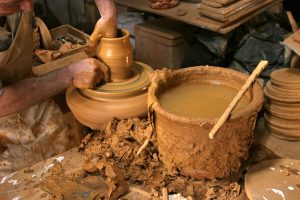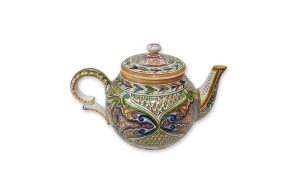Portugal is the land of great sun, great wine, great food and… great ceramics. These are all feel-good factors that come to mind when we think about this great country.
The Portuguese have been working clay since the pre-historic times and today these skilled artisans are turning this ancient heritage to new forms of art.
There are 3 museums in Portugal dedicated exclusively to ceramics:
- The ceramic museum in Caldas da Rainha;
- The pottery museum in Barcelos;
- The tiles museum in Lisbon;
We’ll look at the main cities where ceramics have played a big part on their history.
Caldas da Rainha
Caldas da Rainha, just north of Lisbon, is the unofficial center of pottery in Portugal because of its abundance of clay deposits and wonderful ceramics. In 1884, Rafael Bordalo Pinheiro, opened up a factory of decorative pieces that made the whole town famous. The most traditional and famous ones are Zé Povinho -the bearded peasant everyman- and a cabbage-shaped soup tureen.

Alcobaça
Alcobaça, which is the town where we are from, belongs to the Caldas da Rainha region, it is also abundant in clay deposits and is also very well known for its art. The Alcobaça ceramics are known for being blue painted, which can easily be found in the main square in front of the ancient monastery that was built in the 12th century.

Barcelos
Barcelos is located in the northern region of Portugal, where a very traditional form of clay figures were born. They distinguish themselves from other types of art because of its unique characteristics. The most common ones have a religious and festive nature or everyday life and devilish representations. Although, the most famous one is, without a doubt, the rooster.
There are various variations to this legend, but one of the most famous ones says that a pilgrim who went to Santiago de Compostela, stayed in a famous inn known for the beauty of its owner. She developed a serious passion for the pilgrim, who because of spiritual reasons did not respond to her love. Offended, the woman put a silver spoon inside his baggage and later accused him of stealing it.
The pilgrim requested to be presented to the judge to prove his innocence, who at the time was feasting a rooster. The judge condemned him to be executed and he said that by the time of his execution, the rooster would rise up and sing. He was laughed and mocked.
At the time of his execution, the rooster sang and so he was set free. This rooster is easily one of the most representative Portuguese symbols and is known all around the world.

Coimbra, in the center of Portugal, is also widely known for its ceramics. It possesses the oldest written document related to national ceramics. The pottery in Coimbra represents the eastern tradition -chinese porcelains brought by our sailors during the discoveries. The pieces distinguish themselves from the rest because of their paintings inspired on: the 17th century blue and color drawings representing hunting scenes; Arab influence during the 15th century; feathers and plumages of birds of the 18th century.

Credits_ https://www.ceramicasdecoimbra.com.pt
Besides this famous cities that represent very well the ceramics of Portugal, there’s the most recognisable ceramic art form that we still need to address. It is found everywhere in Portugal.
Azulejo tiles
Ceramic tiles (also called azulejos) are everywhere in Portugal. Literally. They decorate walls of churches, monasteries, palaces, park seats, fountains and train stations. A lot of times they portray scenes from the history of Portugal, breathtaking views from certain spots where you can find them, house numbers or street signs.
They date as far back as the 13th century when the Moors invaded the Iberian Peninsula (now Portugal and Spain). No other country has used these ceramic tiles as extensively and consistently than Portugal. The became art and by the 18th century no other country was producing as much ceramic tiles. For all kinds of reasons and purposes. To this date, they remain a very important part of Portugal’s architecture. Azulejo has its arrabic roots, meaning “small polished stone”.

In this last picture below, you can see the meeting of classic ceramic tiles and one of our contemporary earthenware lamps, perfectly placed together in the nearest train station. Beautiful, right?
Don’t mind him, he’s just waiting for the next bus!


“Share it and spread the knowledge!” _ Done!
This is a fantastic text, very interesting.
Thanks for sharing.
Congratulations and continue the excellent work,
TS
Thank you. Will do!